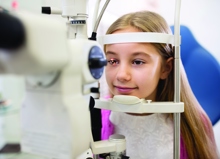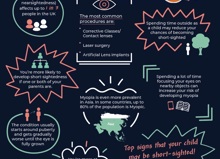What is Myopia?
Myopia, also called short-sightedness or near-sightedness, is an eye condition that causes vision loss at a distance. People with myopic vision can see objects close by while distant objects appear blurry.
The condition occurs when the eye is more elongated than normal or the cornea is curved or sloped. This causes the eye to be unable to focus light correctly, leading to blurry vision at certain distances. Eye problems like myopia are known as refractive errors because they deal with the way the eye processes light.
There are different levels of severity when it comes to myopia and many cases are quite mild. However, the condition tends to get worse as you age and is associated with an increased risk of other eye conditions. Children with myopia may also experience academic or developmental difficulties because of the condition.
The management options for myopia are becoming more effective with options to correct myopic vision and slow down its progression. Catching the condition early also helps to make it more manageable, so routine eye exams are seen as vitally important to help control its effects.
How Common is Myopia?
Myopia is very common and the number of myopic people has grown drastically in the last 20 years.
Recent studies of myopia prevalence have concluded that approximately 23% of the world’s population is myopic and it is predicted that by 2050, it will be nearly 50% (Holden et al, 2016, p. 1039).
Generally, myopia is more common in adults than children. This may be due to the development of the condition as people age and other environmental factors. It’s important to note that myopia is still increasing rapidly in children.
The prevalence of myopia varies widely across race, sex, and environment. In Asia, for example, myopia is especially common among children; some countries have rates as high as 80 and 90%. People in urban environments are almost three times as likely to experience myopia. (Morgan et al, 2021, p. 884 - 886).
Overall, myopia prevalence is rapidly increasing. It is vitally important to catch and manage the condition to help limit its effects.
What are the Symptoms of Myopia?
The main symptom of myopia is reduced vision at a distance. For people with myopia objects further away will appear blurry or unfocused. In children, myopia is commonly spotted when they are unable to read the whiteboard at school or see the television at home.
This reduced vision can lead to other symptoms like eyestrain, headaches, and squinting. Correcting myopic vision effectively can help to reduce these other symptoms as well.
What Causes Myopia?
While the precise cause is not known, there are several genetic and environmental factors that make you more likely to be diagnosed as myopic.
Genetic factors contribute to the likelihood of being myopic — children who have one or more parent who is myopic are more likely to develop the condition themselves.
Activities known as “close work”, like using a computer and reading, have been associated with myopia (Huang et al, 2015). One explanation for the increasing prevalence of the condition is that children and adults spend much more time using screens and less time outdoors. It is also thought that a lack of sunlight may play a role in myopia development, which could also explain the increase in myopic children in recent years.
Non-Surgical Treatment Options for Myopia
The main way to manage myopia is with eyeglasses and contact lenses. There are many myopia management options and the best choice for you depends on your age, lifestyle and the severity of your condition. Contact lenses and eyeglasses have the dual purpose of correcting myopic vision and slowing down the progression of myopia, allowing the user to maintain better vision over time.
There are also several ways of preventing myopia progression in conjunction with glasses or contact lenses. Atropine eye drops are one common method for aiding the control of myopia progression. Higher-concentration atropine drops have been shown to have significant side effects, like light sensitivity and reduced vision at close distances. However, lower-concentration options have reduced the chance of side effects, while still providing good myopia control results.
Eye exercises are also sometimes used to reduce the symptoms associated with myopia. While these exercises cannot correct myopic vision, they have been shown to help people to reduce symptoms like eyestrain and headaches. Maintaining good eye health, taking regular breaks from screen time and having regular eye tests are also all good practices when it comes to myopia.
Surgical Treatment Options for Myopia
There are several safe and effective surgical treatments for myopia. Surgery for myopia can provide a permanent solution in some cases and can be used to correct severely myopic vision. Compared to other management options, there are greater risks associated with surgery, but these are relatively low.
Laser-assisted in-situ keratomileusis (LASIK), sometimes called laser eye surgery, is a popular option for treating myopia. LASIK works by making a tiny incision in the cornea and reshaping it. The main problem with the surgery is that sometimes it needs to be repeated to get a successful result (NHS, 2020). Other uncommon side effects include dry eye, infection and in very few cases vision impairment.
Photorefractive keratectomy (PRK) is another form of laser eye surgery. This procedure is slightly different in that a thin layer on top of the cornea is removed. The cornea is then reshaped and the layer is allowed to regrow naturally. It is a newer treatment and some consider it to be safer and more effective than LASIK.
Corrective Lenses vs. Contact Lenses for Myopia
Both corrective spectacle lenses and contact lenses are used to manage myopia. They can both be effective and your optometrist will help you decide which is the best option for you.
Myopia-control eyeglasses are usually used to manage mild myopia. They correct myopic vision by redirecting light based on the shape of the cornea. To slow down myopia progression they refocus light in front of the retina in a way that has been linked to slowing down or stopping the elongating of the eyeball. They are a simple and affordable way to correct myopia. However, glasses are less effective at treating more advanced cases of myopia and make it more difficult to participate in active pastimes.

Myopia-control contact lenses are generally thought to be more effective than corrective eyeglasses. There are many different types available, but most work in the same way as spectacle lenses by refocusing light in front of the retina. New types of contact lenses reshape the eye overnight, providing vision correction the next day. The downsides of contact lenses include the difficulties of getting used to them and discomfort while wearing them. They also require some special care and it’s important that users follow the right hygiene and care procedures.
Tips for Choosing the Right Glasses for Myopia
Choosing the right glasses can allow you to manage your myopia in a way that’s good for your vision, eye health and lifestyle. Here are some tips to help you make your choice:
- Research the different options available. There is a wide variety of glasses and people have provided feedback on their experience with each.
- Choose frames you find comfortable. Your glasses won’t work if you aren’t wearing them regularly, so it’s important you find a pair that is comfortable for you.
- Listen to your optometrist. In most cases, your optometrist will have years of experience with managing myopia and will be able to provide you with expert advice.
Types of Contact Lenses for Myopia
There are many types of myopia-control contact lenses with different materials, designs and brands to choose from.
Soft contact lenses are the most common. They are made of a flexible and permeable material that keeps the eye oxygenated and moist. They are generally considered to be a comfortable and effective option, with daily, bi-monthly and monthly disposable options. Soft lenses provide corrected vision and some can also slow down myopia progression.
Rigid Gas Permeable (RGP) lenses are a less common option for myopia control but are often more effective at slowing down the rate of myopia progression. These contact lenses are specially designed for your eyes and can actually reshape the cornea. One downside of these lenses is that they can take a long time to get used to and some people find them less comfortable than soft options.
Orthokeratology lenses (Ortho K) are worn overnight when they gently reshape the cornea to provide corrected vision during the day. They are also an effective myopia control option. Like RGP lenses they can take some getting used to and may be uncomfortable initially. They may also be a more expensive option than other types of contact lenses.
Tips for Choosing the Right Contact Lenses for Myopia
Contact lenses affect your vision, comfort and routine so choosing the right ones can make a significant difference to your well-being. Here are some tips to help you make your choice:
- Research your options. Lenses come in many different materials and designs which can make a big difference in terms of comfort, routine and effectiveness.
- Trial your lenses. Trying out lenses allows you to see how they feel and how effective they are.
- Listen to your optometrist. As with glasses, your optometrist is your best source of information about which contact lenses will work for you.
Signs and Symptoms of Myopia in Children
It can be difficult for children to know when they are experiencing vision loss. As myopia gets worse gradually, they will often not notice until the condition becomes more advanced. This is why it is important to have their eyes tested regularly and to look out for the signs and symptoms of myopia.
Children will experience the typical symptoms of myopia: blurry vision at a distance, eyestrain, headaches and squinting.

There are also some signs to look out for that may help you to spot myopia:
- Having to sit close to the television
- Complaining about not being able to read the whiteboard or projector at school
- Frequent headaches or eye pain
- Changes in academic performance
While these are not always signs of myopia, it is advisable to have your child’s eyes tested if you notice them.
Diagnosis and Treatment Options for Myopia in Children
Optometrists can diagnose myopia during a comprehensive eye exam. The diagnosis can be made after a visual acuity test and a refraction test, which can also calculate your prescription.
If you are diagnosed with myopia your optometrist will explain your options to you. These will likely include vision correction and myopia control through contact lenses or eyeglasses. If your myopia is more advanced they may also explain surgical options to you like LASIK and PRK.

Tips for Preventing Myopia in Children
Anyone can be myopic and there is no way to guarantee your child won’t get the condition. However, there are a few things you can do to help children keep their eyes healthy and minimise their risk of developing an eye condition like myopia:
- Regular eye exams. Having your child’s eyes regularly tested is the most important part of looking after their eye health.
- Breaks from screen time. Close work has been linked to myopia development, so encouraging children to take breaks is a good idea.
- Protect their eyes from the sun. Wearing proper eyewear and avoiding too much direct sunlight can help to protect eye health.
- Improve general health. Diet, exercise and time outdoors all have an effect on your eyes and staying healthy is an important part of eye care.
Tips for Managing Myopia in Adults
Myopia is a condition often associated with children, but it is also something many adults have to live with. The condition can also develop later in life so it is important for adults to look out for the signs and symptoms and not to miss routine eye exams.
Choosing how to correct your vision can also be a challenge, but finding the right solution for you can make a big difference to your eye health and quality of life.
As myopia increases the risk of other serious eye conditions like glaucoma and retinal detachment, it is especially important for myopic adults to have their eyes regularly tested.
Factors to Consider When Choosing a Myopia Treatment
Choosing how to manage or treat your myopia is a big decision that can have long-term effects on your health, eyesight and well-being. With the help of an optometrist, you should consider factors like your age, how much your myopia has progressed and how each treatment option will affect your lifestyle. Considering how much time you spend outdoors, working at a computer and exposed to sunlight, can help you make an informed decision. Researching the different options available and discussing any potential risks with your optometrist is also an essential step.
It is important to remember that managing myopia is a long-term process, which means you need to keep considering your eye health and stay up-to-date with your regular eye exams.
Common Myopia Myths
Myopia research has come a long way and staying in the know about the latest information can help you protect your eye health. To make things easy, here are some myths and facts about the condition.
Myth: Wearing glasses or contact lenses can make myopia worse.
Fact: Myopia tends to get worse over time regardless of whether you use glasses or contact lenses. Certain types of lenses can help to slow down the progression of myopia.
Myth: Myopia is not serious and doesn’t require specialised treatment.
Fact: Myopia can cause severe vision loss and complications of myopia can even lead to blindness. Myopia also increases your risk of developing serious eye conditions later in life.
Myth: Myopia can be treated using eye exercises.
Fact: Eye exercises can help to relieve eyestrain but they cannot correct or cure myopic vision.
Myth: Sitting too close to the television or computer screen can cause myopia.
Fact: Some kinds of “close work” like reading and using computers have been associated with myopia.
References
Holden, B. A., Fricke, T. R., Wilson, D. A., Jong, M., Naidoo, K. S., Sankaridurg, P., & Resnikoff, S. (2016). Global prevalence of myopia and high myopia and temporal trends from 2000 through 2050. Ophthalmology, 123(5), 1036-1042. https://doi.org/10.1016/j.ophtha.2016.01.006
Huang H. M., Chang D. S. T., Wu P. C. (2015) The Association between Near Work Activities and Myopia in Children—A Systematic Review and Meta-Analysis. PLOS ONE, 10(10). https://doi.org/10.1371/journal.pone.0140419
NHS. (2020, 21 April). Laser eye surgery and lens surgery. https://www.nhs.uk/conditions/laser-eye-surgery-and-lens-surgery/
Morgan, I. G., French, A. N., Ashby, R. S., Guo, X., Ding, X., He, M., & Rose, K. A. (2021). Global variations and time trends in the prevalence of childhood myopia, a systematic review and quantitative meta-analysis: implications for aetiology and early prevention. British Journal of Ophthalmology, 105(2), 162-167. https://doi.org/10.1136/bjophthalmol-2020-316345





